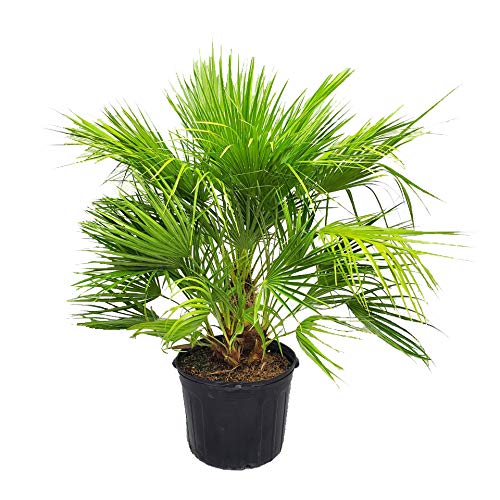How to Add an Exotic Palm Tree to Your Yard – And an Expert's Pick of the Best Ones for Small Spaces
Find out how to plant a palm tree – and where you should and shouldn't grow them – with our easy guide to getting the most out of these tropical beauties
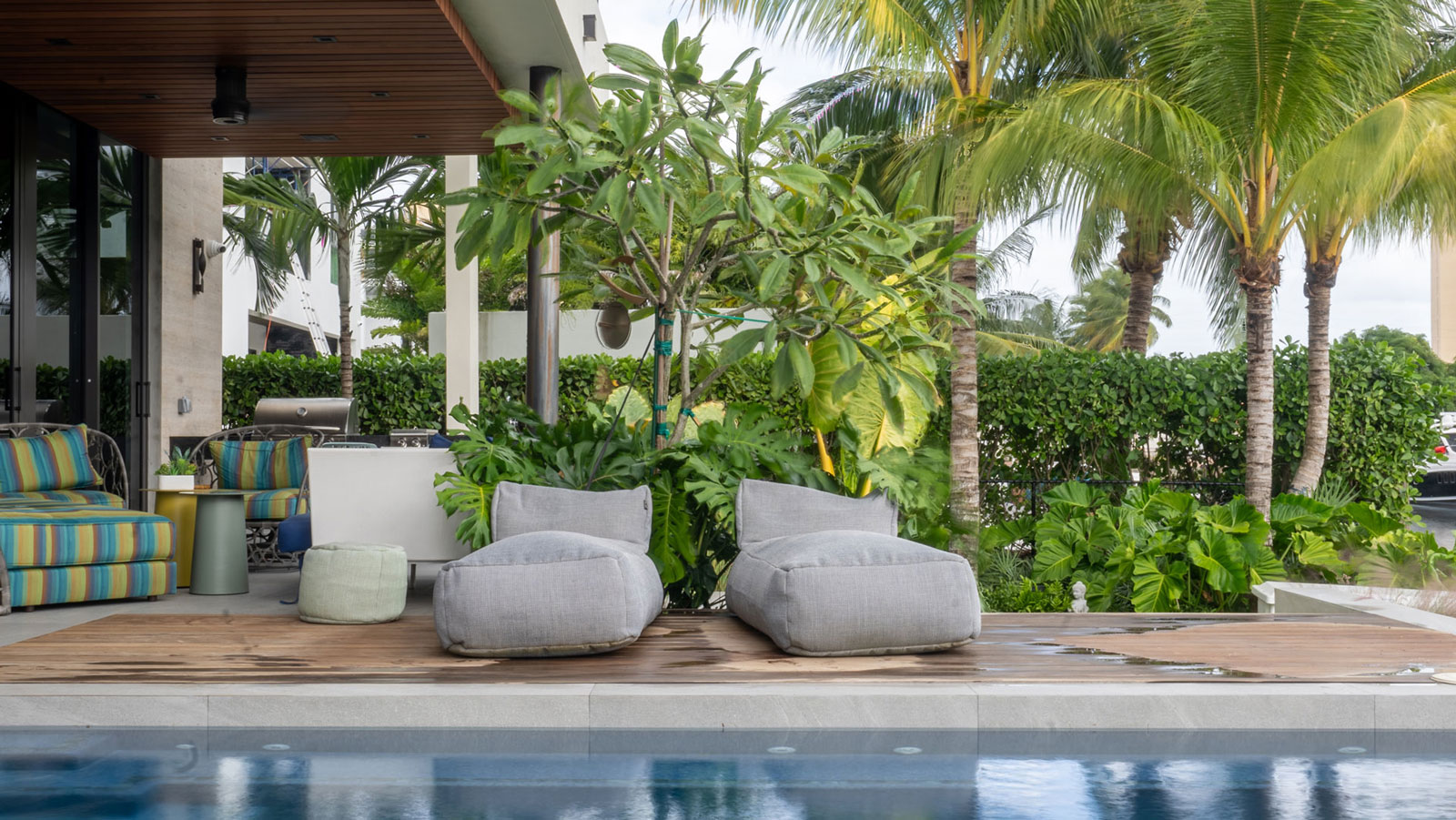
Easy care palm trees are a low maintenance option once planted and established in your yard yet offer so much in terms of adding tropical good looks to your outdoor aesthetic. While they generally need plenty of sun and warm temperatures to thrive, many species are surprisingly cold hardy and shade tolerant.
Palms add a sensory touch with the rustle of fronds shifting in the breeze, and beautifully textured trunks. Plant one to introduce an architectural element that will anchor your design with its bold, symmetrical foliage. The shapely trunk will add an important vertical element to your modern garden's planting. A palm will also cast dappled shade and throw decorative shadows on patios and walls. Meanwhile a dramatically uplit palm tree transforms the night garden.
In addition to a range of green colors, cold-hardy species like the Mexican blue palm add a cool silver note to the planting palette in temperate climates like California and the Southeastern US, while the lush fruit and scented flowers come in shades of gold, black, red and purple.
So whether you want a single dramatic punctuation point in the landscape, or a cluster of small palms as an understorey, palm trees create an easy sculptural focal point. There are also many varieties of palm that will thrive for years in a container if you're short on space but want to bring a tropical touch to a small landscape. Now find out how to get the look in your yard.
When to plant a palm tree
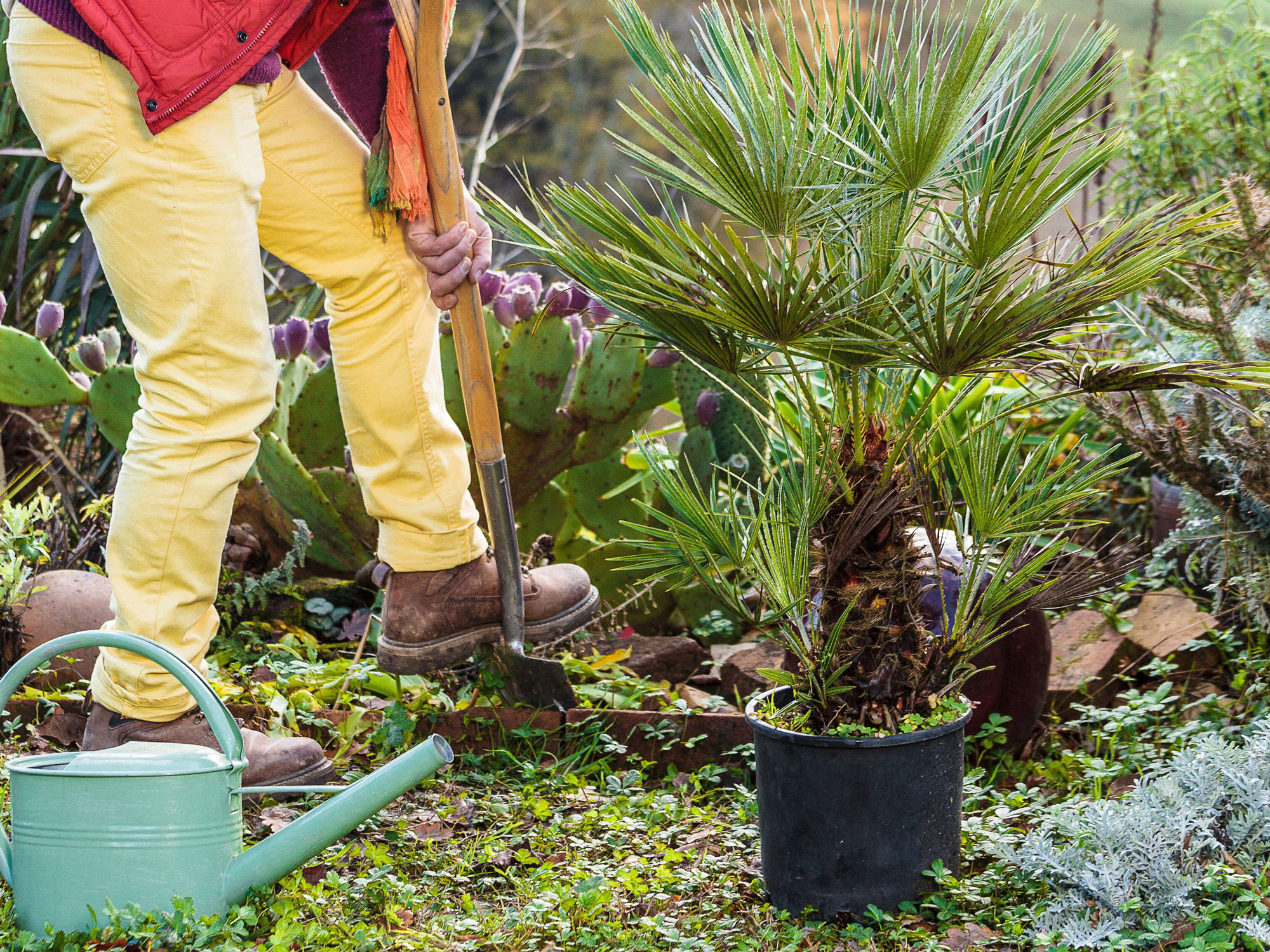
Make sure your newly planted palm tree has time to get established before cooler weather sets in
'Palm trees are a popular sight in arid gardens with their skinny trunks and clusters of fronds at the top,' says horticulturist, arborist and landscape consultant Noelle Johnson, author of Dry Climate Gardening.
'Unlike other plants, however, they have a specific time of year when they need to be planted. They require warm soil when they go in the ground, typically 65°F or over, and late spring and early summer are ideal times for adding palms to your garden.' This way your palm gets 5 to 6 months to get established before cooler weather sets in.
Before deciding on a palm species for your tree landscaping, check its sensitivity to cold, and decide if it can handle your climate. Avoid planting palm trees during the dry season too as young palms are more susceptible to challenging conditions such as extreme heat and drought.
Where to plant a palm tree
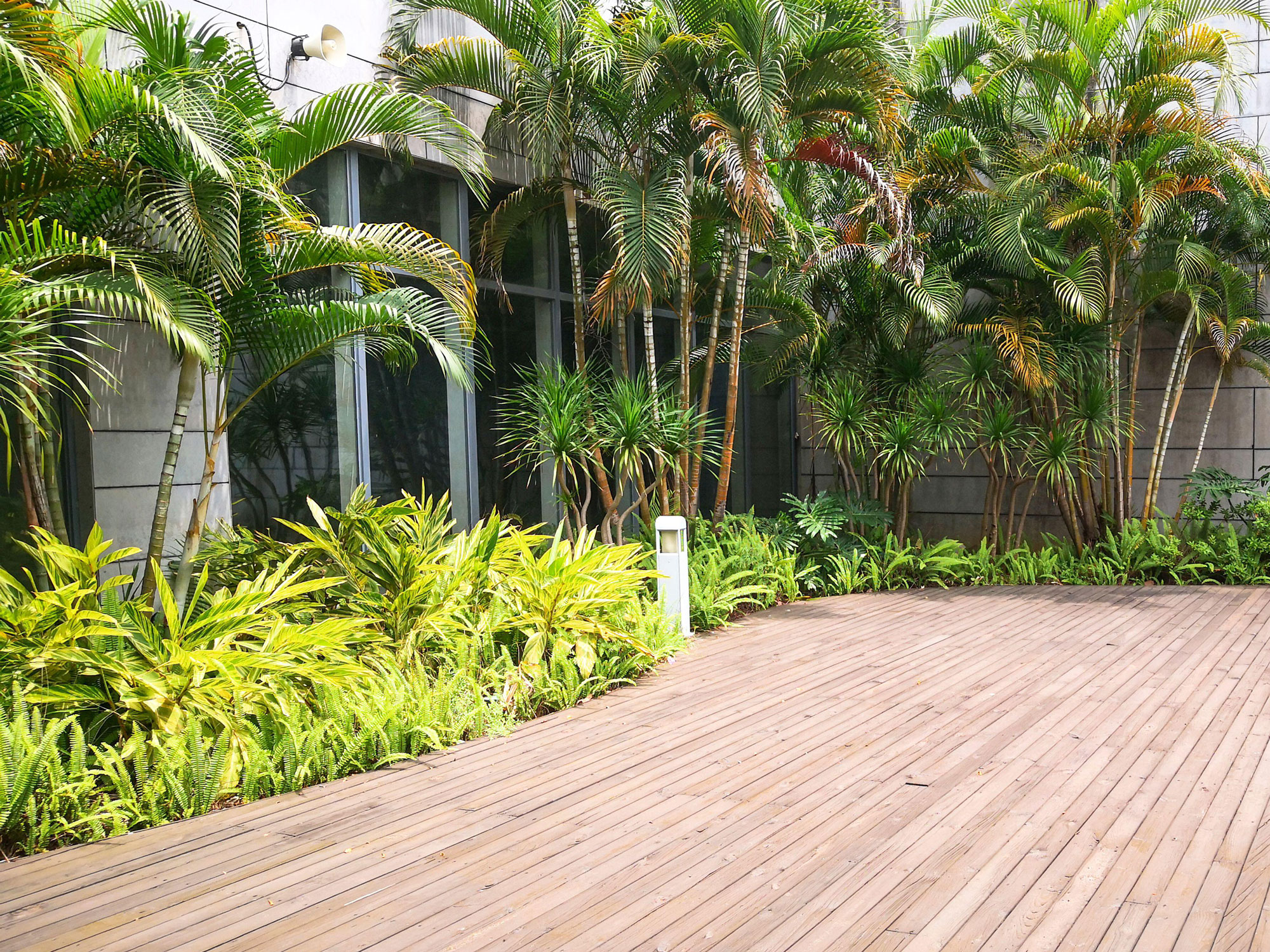
A sheltered deck offers the perfect growing conditions for young palm trees
Palm trees need the right climate to thrive. In the US most palm trees are grown in the warmer temperatures of the Southeast, but you can get some hardier varieties that will grow in cooler climates and withstand cold temperatures. Before buying always check the hardiness zone and climate preferences of the palm to make sure it will survive in your environment.
Most palm trees like a warm, sheltered spot in a backyard and dry conditions in winter, as extreme cold and overly wet conditions can easily kill them. An enclosed courtyard garden is ideal. Be prepared to wrap them for protection if frost is an issue where you live, at least until they’re well established. If your palm tree is cold-sensitive, again the best place to plant it is in a sheltered courtyard to protect it from chill winter weather.
Smaller varieties of palm trees are happy growing in containers too, which can then be moved to a more sheltered spot or indoors in winter. If the palm is a large one and too heavy to move, protect it with a frost cloth or bubble wrap to protect plants from frost. Take care to keep water off palm leaves as this will cause damage if it freezes.
How to plant a palm tree
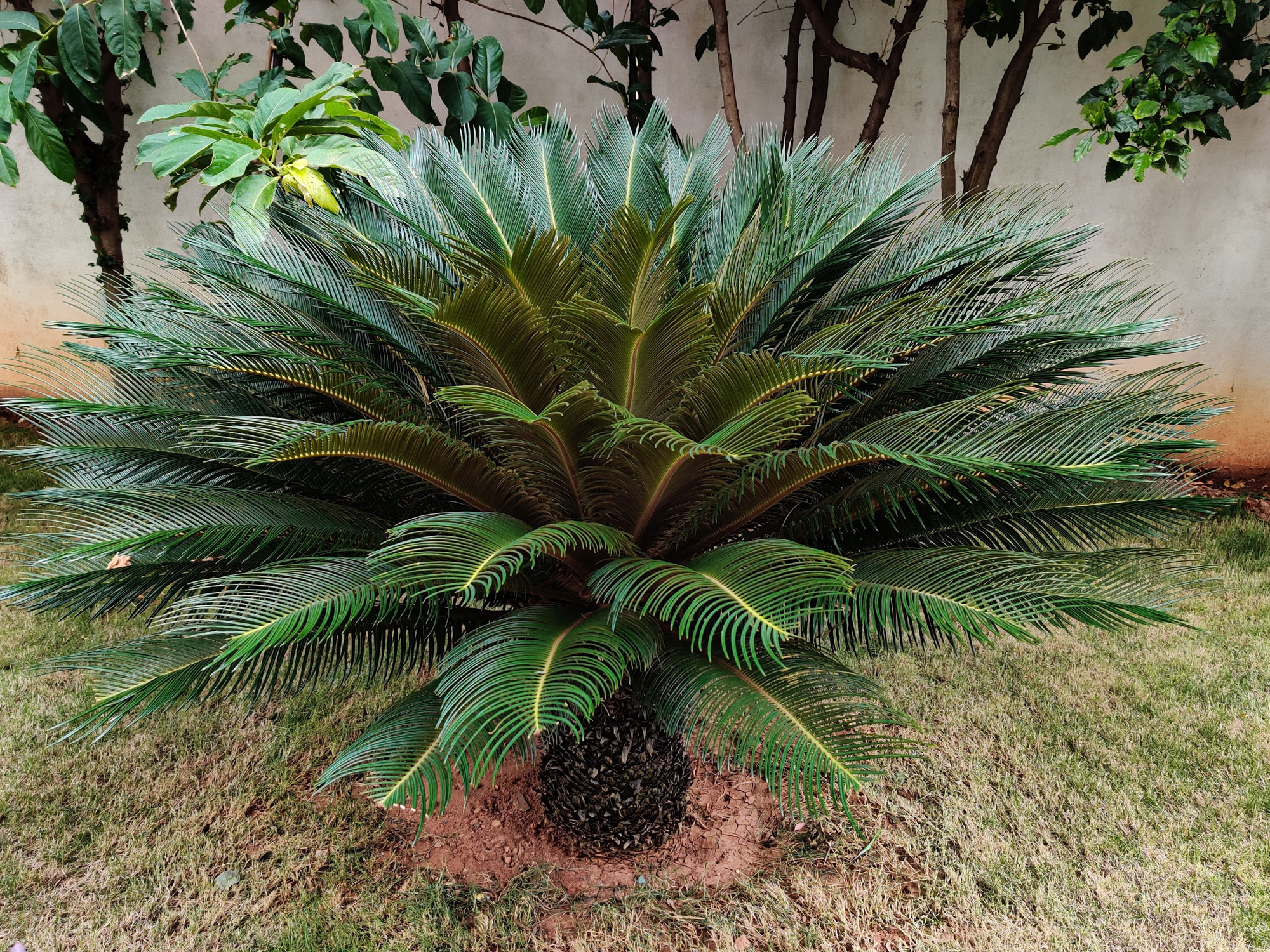
Handle the root balls of young palms carefully when planting
Once you've decided on a palm tree and brought it home it's time to get it planted. Dig a hole at least twice as wide as the diameter of the root ball, and just deep enough to accommodate the root ball.
Take great care when handling your new palm tree, especially the root ball when removing it from the container. Once the tree is out of the pot, level the hole so the bottom of the trunk is flush with the surface of the soil, then backfill with loose soil.
Newly planted palm trees need support as they are top heavy and may topple during strong winds. Bracing a palm generally works better than staking it. Use three or four pieces of 2x4 lumber spaced equally around the palm. Fasten by wrapping burlap around the trunk.
What your palm tree needs to thrive
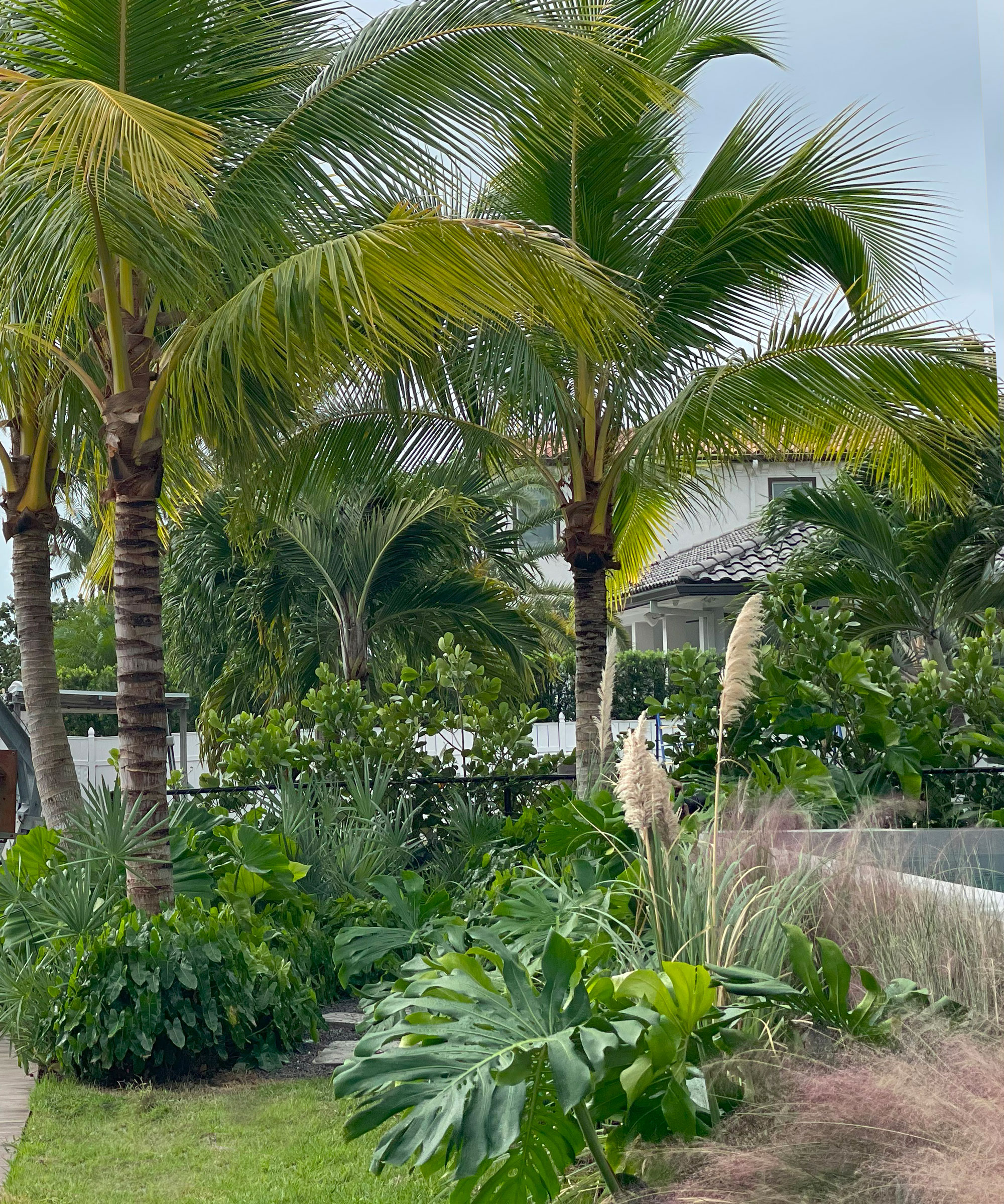
Palms need to the right soil to grow into healthy trees like these ones, and will benefit from palm fertilizer too
Most palms grow best in full sun but there are some varieties that will do well in partial shade or indirect light too. They tend to prefer well-draining soil but it's always best to check the requirements of each variety before you buy.
Many types of palms are drought resistant but others will need regular watering so again always check the preferences of the variety you have chosen and respond accordingly to what it likes. Given the climate they grow in, you might think palms are ideal for dry gardens, but remember that palms are trees that thrive in an oasis, so they need water, particularly in the first few years until the tree is established in your yard.
Palm trees also need fertilizer in the spring and fall or when being planted if it's during their growing season. The easiest option is to choose a fertilizer spike, which is a fast, efficient, long lasting method to feed your palm tree. Look for an all-purpose fertilizer spike containing nitrogen plus soluble minerals.
3 of the best palm trees for small gardens
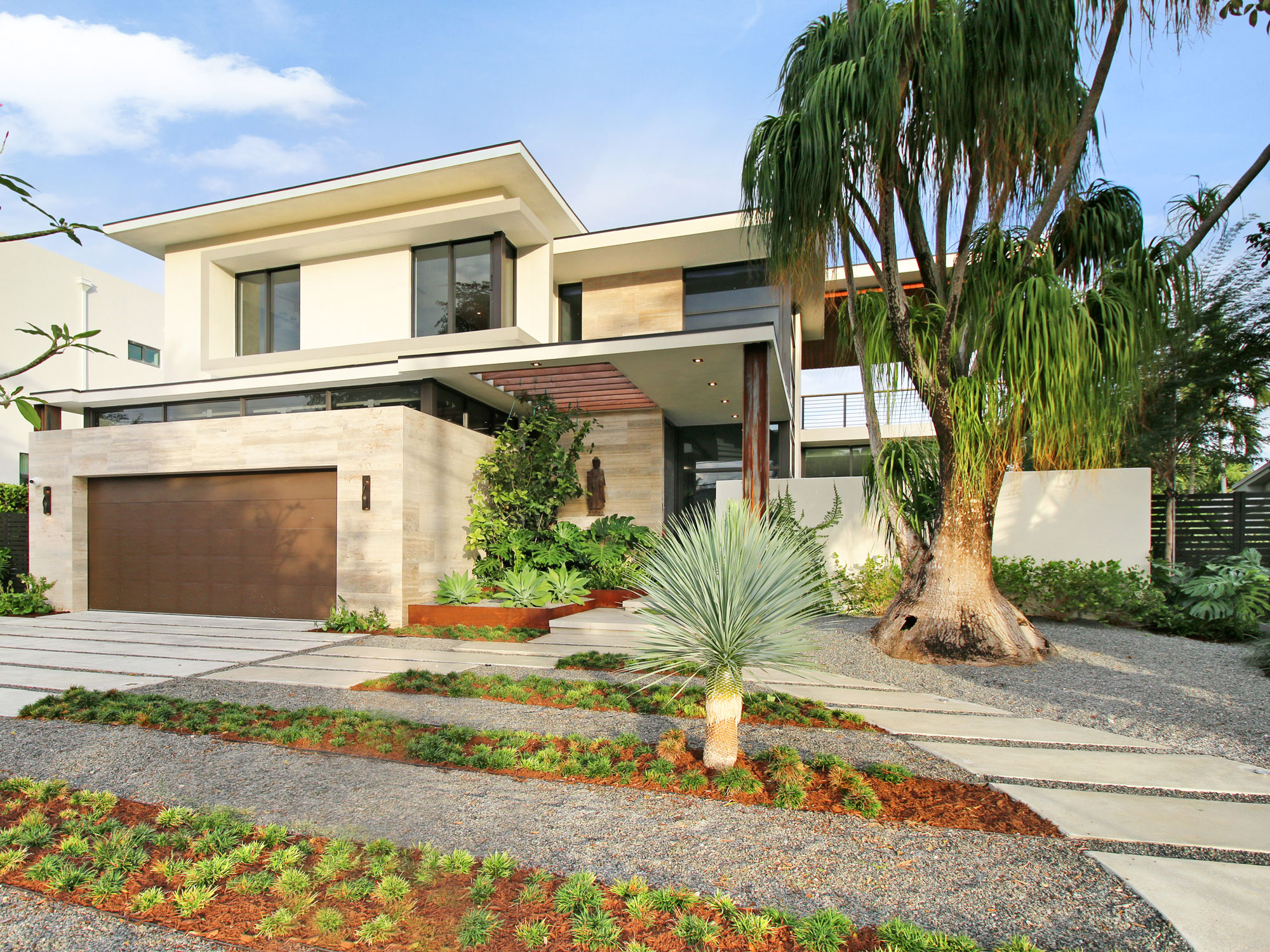
A majestic ponytail palm tree frames the entrance in this Miami front yard design by Studio Arth, which also features a curved walkway, and a combination of stepped planters and corten steel-held gravel. Other planting includes mondo grass, wart fern, Strongylodon (jade vine) and spineless Agave
You might think most palm trees are pretty similar but in fact there are over 2,500 different species to choose from. They come in all shapes and sizes, from petite ones that suit pots or under planting to majestic towering types that make a statement. Be sure there's one for every style of garden design.
It's always a good idea to check the mature size and growth rate of your tree to make sure you have enough space to accommodate it. Here dry climate gardening expert Noelle Johnson picks three of her top choices for palm trees that will thrive in an urban space.
1. Mexican blue fan palm
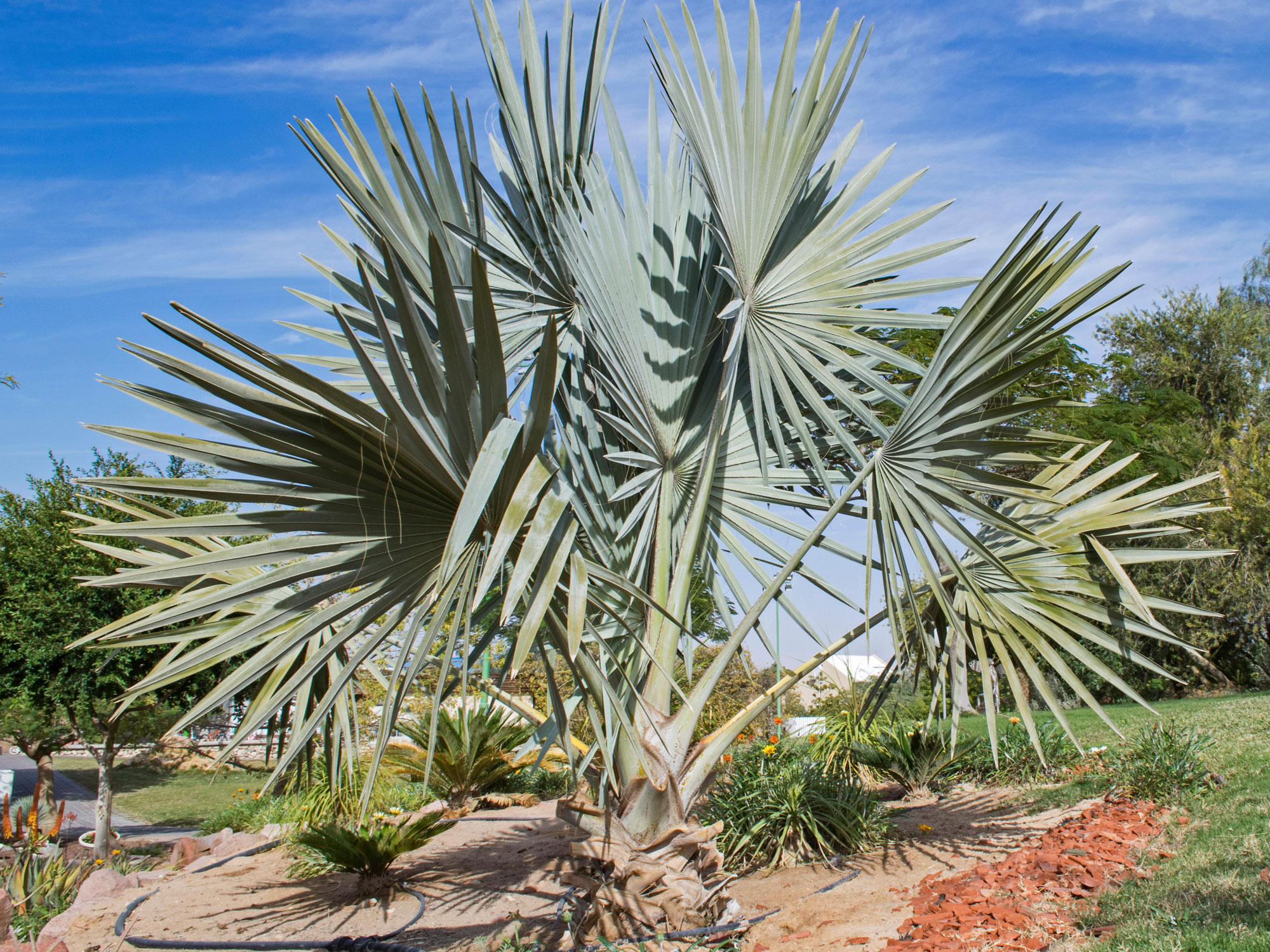
Grown for its silver-blue-green fronds, this variety of palm tree makes a real statement plant in your landscape with its fan-shaped foliage and graceful arching fronds. Another plus is that this palm (Brahea armata) is cold hardy in Zones 9-11.
'With lovely flowering plumes the Mexican blue fan palm makes a showy addition to the garden,' says Noelle. 'In late summer/early fall, prune away fronds that are significantly drooping. Fruiting plumes can be removed at any time. Take special care not to over-prune as it may not recover. Apply a palm fertilizer in early summer.' Why not try these palm fertilizer spikes from Amazon?
This variety of palm is slow-growing, so it's worth buying a larger specimen if you have room to accommodate it. Plant it where it will have plenty of room to grow as it will eventually reach a height of 20 feet or more with a spread of 10 feet. It's a drought tolerant palm requires little irrigation once established.
2. Mediterranean fan palm
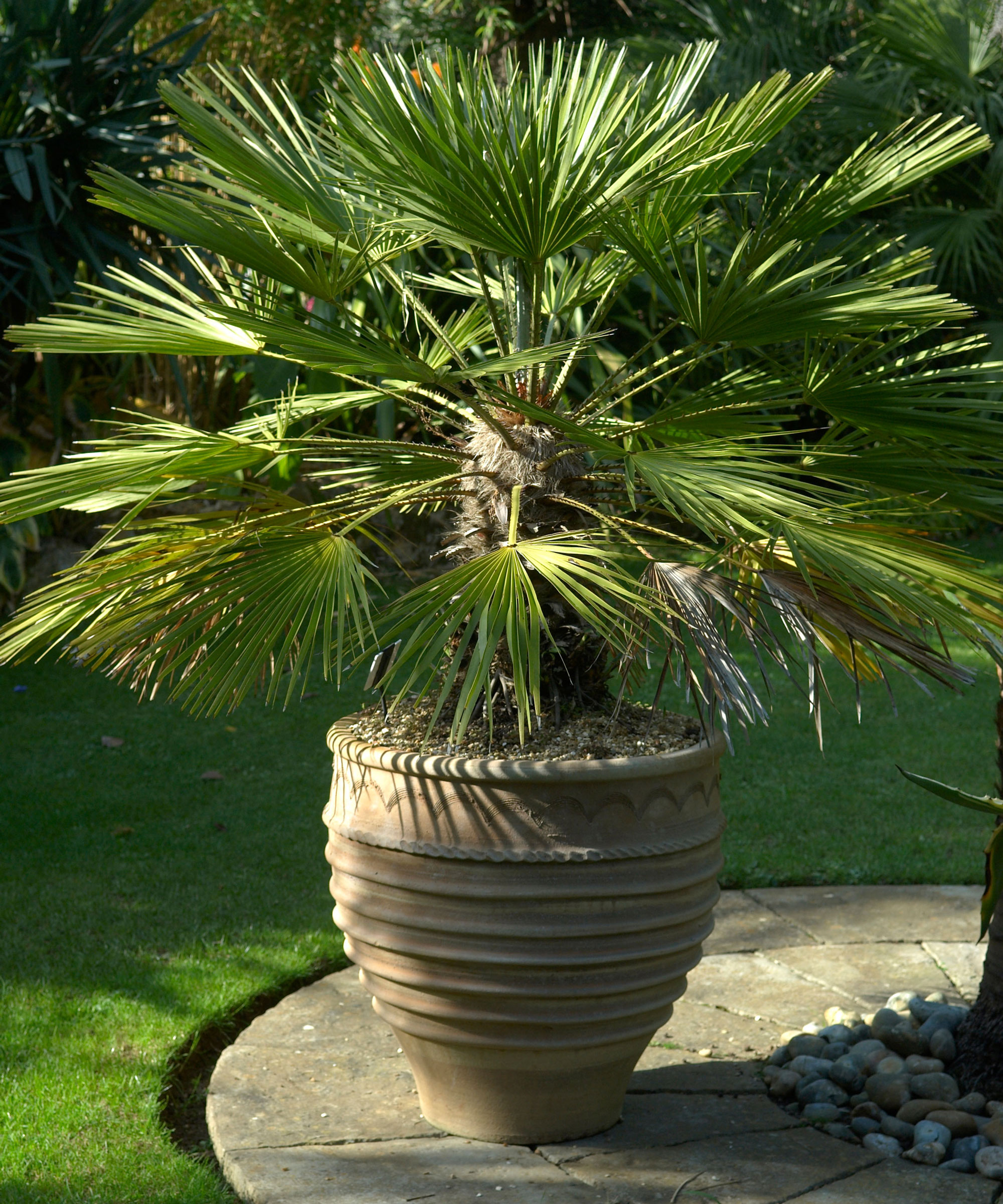
This variety is a great choice for smaller yards as it doesn’t overwhelm the landscape with its size. It grows to 15-20 feet with a spread of 15-20 feet, and will look particularly good planted near a pool or potted up in a large container.
'Fan-shaped fronds grace the multiple trunks of this medium-sized palm tree,' says Noelle. 'The bright green color of the foliage and clumping growth habit make this palm a big favorite in both arid and colder, wetter climates.'
The Mediterranean fan palm (as known as European fan palm, and Chamaerops humilis) is quite hardy, performing well in zones 8 through 11, and even as low as 7b if you offer it protection.
Small, pale yellow flowering stalks are produced followed by black fruit. Prune in late summer/early fall, removing any palm fronds that are drooping or turning yellow. The fruiting branch can be removed at the same time. The best time to feed them is in early summer with a palm tree fertilizer.
3. Pygmy date palm

The dainty pygmy date palm (Phoenix roebelenii) is another great choice for small urban gardens as it grows only 5–10 feet tall with a spread of 5–6 feet, and looks good planted up in a container garden too.
'The featherlike leaves provide a nice arching growth habit,' says Noelle. 'Pygmy date palms are commonly grown as multi-trunk palms but can also be trained into a single trunk. In spring, small yellow flowers turn into clusters of black date fruit.'
Use where you want to add an oasis-like feel near a pool or patio, and live in Zones 9-11. Avoid planting in areas with reflected heat, particularly in low-desert climates where afternoon shade is preferred. Limit trunks to three or five and prune away the rest at the base as they appear. Remove palm fronds as they turn yellow and brown in late summer or early fall. The best time to feed them is in early summer with a palm tree fertilizer.
How close to a house can you plant a palm tree?
If you want to plant a palm tree close to your house choose one of the smaller varieties, such as the pygmy date palm or the Mediterranean fan palm. They generally require being planted a minimum of 3 to 5 feet from the house. Don't worry about the roots causing problems with foundations, sidewalks or retaining walls as the roots aren't invasive.
Be The First To Know
The Livingetc newsletters are your inside source for what’s shaping interiors now - and what’s next. Discover trend forecasts, smart style ideas, and curated shopping inspiration that brings design to life. Subscribe today and stay ahead of the curve.
Lifestyle journalist Sarah Wilson writes about flowers, plants, garden design and trends. She has studied introductory garden and landscape design and floristry, and also has an RHS Level 2 qualification in the Principles of Plant Growth and Development. In addition to homesandgardens.com and livingetc.com she's written for gardeningetc.com, Real Homes, Modern Gardens and Country Homes & Interiors magazines. Her first job was at Elle magazine, during which time a trip to the beautiful La Colombe d'Or in St-Paul-de-Vence led to an interest in writing about all things botanical. Later as lifestyle editor at Country Homes & Interiors magazine the real pull was the run of captivating country gardens that were featured.
-
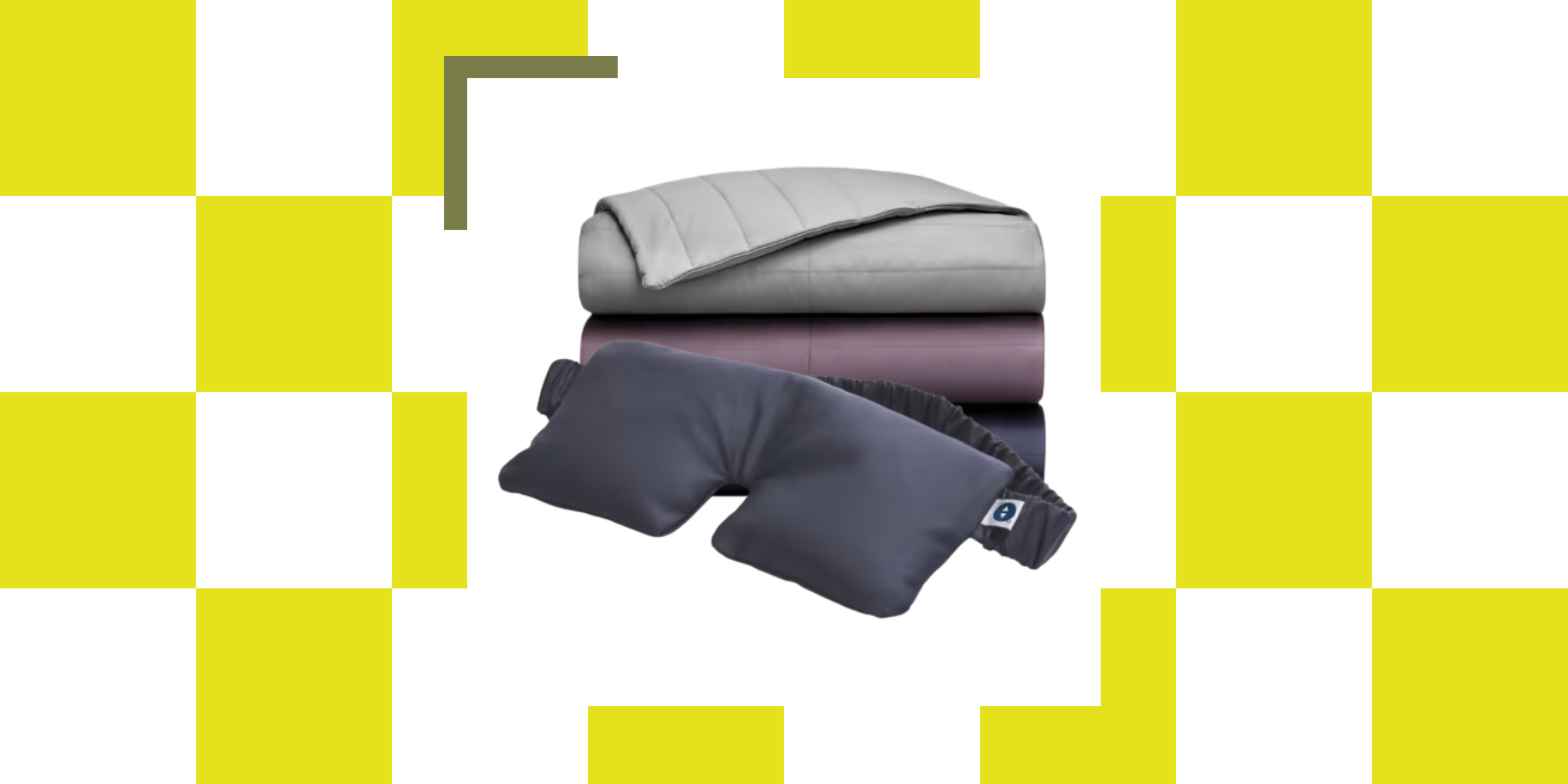 The Weighted Blanket That Doesn’t Make You Sweat (and the Eye Mask to Match)
The Weighted Blanket That Doesn’t Make You Sweat (and the Eye Mask to Match)Luxury has weight. And apparently, volcanic minerals
By Julia Demer
-
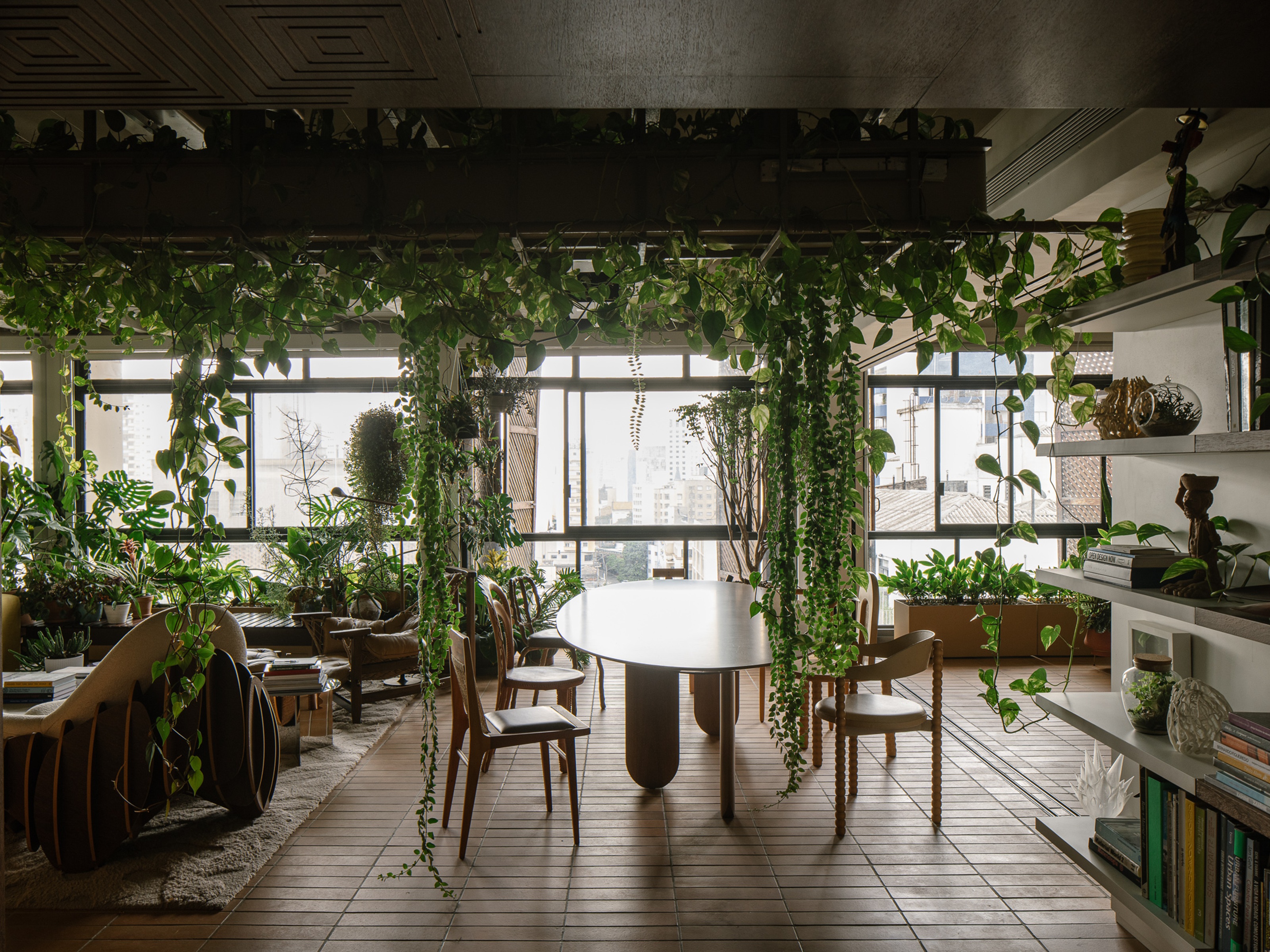 What Is Biophilic Interior Design? I'm an Actual Biophilic Designer, and This Is How to Apply It to Your Home
What Is Biophilic Interior Design? I'm an Actual Biophilic Designer, and This Is How to Apply It to Your HomeA biophilic designer explains the core principles of this practice, and the easy ways you can apply it to your home's design
By Marianna Popejoy
